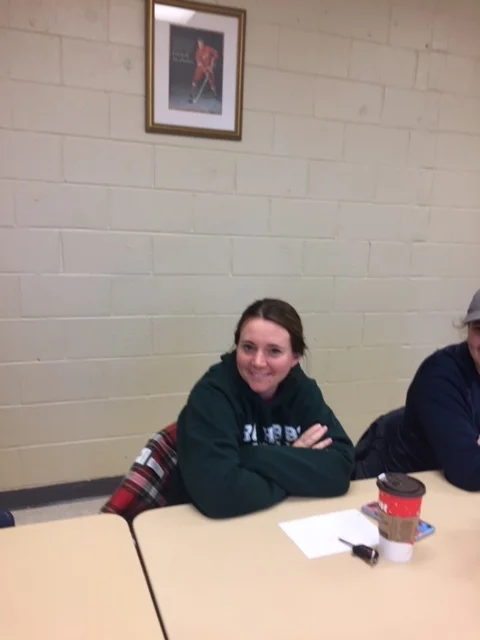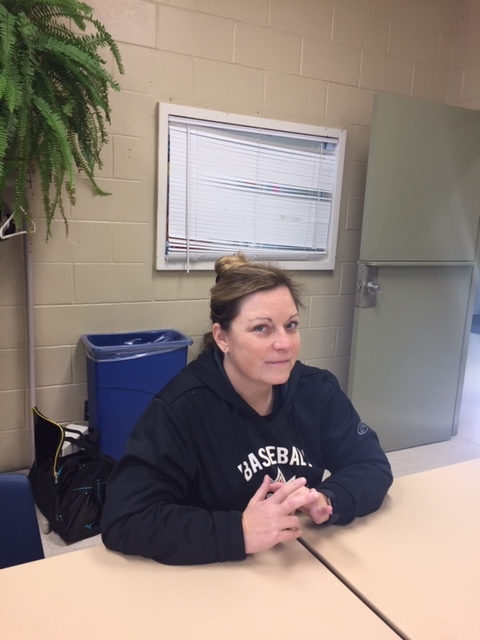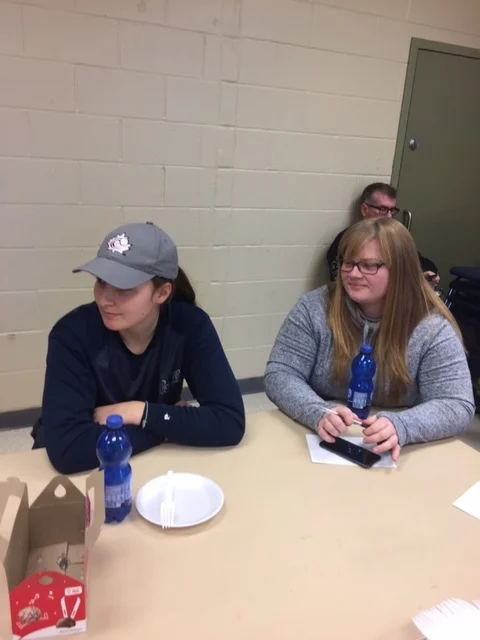Part II: A Sport of Their Own - Talkin’ baseball: From sexism to career success
Royal York players Miranda MacCormack (left) and Meghan MacCormick (right) participate in a discussion about girls’ and women’s baseball in Canada.
This is the second in a five-part series called A Sport of Their Own. Next: Canada’s national team a world power.
You can read Part 1 - Thousands of girls, women playing baseball in Canada here.
*******
Talkin’ baseball: From sexism to career success
By Scott Langdon
Canadian Baseball Network
The 13-year-old girl asked her dad a straightforward question. He is still working on his answer almost a quarter century later.
“In 1995 or 1996 my daughter Meghan asked me why her brother could play baseball, but she and other girls had to play softball. Good question. So, with some friends we did a phone survey of the parents of girls playing softball in our association. About 80 per cent responded in favor of baseball,” said Alan Waffle, then a volunteer executive, Islington Minor Baseball League (IMBL) in west end Toronto.
“It took a couple of years to really get a house league going. We had about 80 or 90 girls who wanted to play,” added Waffle, who today is president, Royal York Baseball Association, an amalgam of the IMBL, Etobicoke Girls’ Baseball League and a few other local leagues.
Michelle Johnston, 37, played in that first house league and remembers it fondly.
“We played in the house league and some select tournaments. Then we played in the Central Ontario Girls Baseball League (COGBL) when it was formed in 1996. I vividly remember how difficult the transition was from softball rep to house league and select baseball,” she said. “We often quoted the movie A League of Their Own and spoke about it. I guarantee that all the girls of my era know every single word of that movie. Very inspirational.”
Royal York was one of the featured teams in the COGBL among the up to 12 that participated. Canada’s first national women’s team, formed to play in an international tournament and then the first Women’s World Series at Toronto’s SkyDome (now Rogers Centre) in 2001, consisted mostly of Royal York players.
The COGBL has morphed into the Ontario Women’s Baseball League (OWBL), “the longest, continuous, all-female baseball league in existence in Canada” according to its web site (www.owbl.ca).
The Canadian Baseball Network recently invited a group of girls and women spanning four generations from so-called Gen Z (15 years old and under) to Baby Boomers (over 55 years) from west end Toronto to talk about girls’ and women’s baseball and to share experiences and stories spanning five decades. The Baby Boomers didn’t have the opportunity to play baseball in their youth when “girls played softball” while others have played baseball for two thirds of their young lives.
The participants are: current Royal York players Meghan MacCormack, 15, and Miranda MacCormack, 16; OWBL Royal York players Hannah Pelletier, 17 and Janet Moore, 32; OWBL Annette player Kylie O’Donnell, 29; Judith Mills, 69 and Cathie Hughes, 70, who last played three-pitch softball in the defunct and affectionately-known “Light Days League” in west end Toronto. Lisa Turbitt, 49, Canada’s premier female umpire with more than 16 national and international championships to her credit, rounded out the group.
CBN: Meghan and Miranda, how long have you played baseball?
Megan: For about 10 years. My dad got me into it. I started with boys, but as I got older it has become more fun to play with girls. I’m used to it and I know how to play baseball more than I know how to play softball. I only play softball at school.
Miranda: Ten years…we started out at Annette Baseball playing with boys, then moved to Royal York for girls’ baseball.
“A woman may take part in the grandstand, with applause for the brilliant play, with waving handkerchief to the hero, but she couldn’t actually play. Base Ball is too strenuous for womankind.”
America’s National Pastime, published 1911, A.G. Spalding
Cathie Hughes (left) and Judith Mills (right) participate in a discussion about girls’ and women’s baseball in Canada.
CBN: Judith and Cathie, how do you feel when you hear this from Meghan and Miranda?
Cathie: It’s awesome. Absolutely awesome.
Judith: I’m proud to hear this. They know how to throw a ball. They have the skills.
Cathie: We played three-pitch softball in grade eight. That was the only sport we were basically playing as girls. Girls weren’t allowed to play hockey or football.
Judith: The girls in our day didn’t know much of anything about baseball. I grew up in a small town. There was no baseball for girls. Nobody taught us.
“Girls were considered too frail to play baseball.”
Sue Zipay, 84, Rockford Peaches, AAGPBL, 1953/4
Janet Moore recently participated in a discussion about girls’ and women’s baseball in Canada.
CBN: Those of you who have played baseball, what did you think when you first had the opportunity?
Janet: I’ve never played club softball, just in school. I’ve always played baseball. I started in the COGBL in 2001 when I was 14. It was awesome. Three quarters of the Royal York team played for Team Canada. Most of the rest were from Burlington. So, as a 14-year-old who had just switched from boys’ hardball to girls’ hardball, it was amazing. I had so many mentors to look up to.
Kylie: I joined the COGBL in 2001 when I was 11, recruited from a mixed gender league. I never played softball. Being able to play with girls was awesome at that elevated skill level. It helped me make Team Ontario. We didn’t know baseball wasn’t an option.
Umpire Lisa Turbitt recently shared her experiences in a discussion about girls’ and women’s baseball in Canada.
Lisa: I can remember my Mom told me the playgrounds at school were divided for boys and girls at one time. I played baseball with boys in my younger days.
“Are you crying? Are you crying? There’s no crying. There’s no crying in baseball.”
Manager Jimmy Dugan to player Evelyn Gardner
A League of Their Own, 1992
Judith: In those days, girls playing with boys had huge issues. When it happened there would be stories in the newspaper about it.
Kylie: I can still remember our Toronto Fusion team wanting to play exhibition games against boys’ teams to get ready for a tournament. A local convenor told us, “Boys playing with girls is like cats playing with dogs.” And that was just three or four years ago. So, it still happens. We were older than the boys and they didn’t think that would be fair.
“I was comfortable at first base. I started half the season. My teammates were confident in me.”
Samantha Magalas, the first woman to play men’s university baseball in Canada (2004); member, Canada’s Women’s National Team (2004-2009)
Hannah Pelletier (left) and Kyle O’Donnell participate in a discussion about girls’ and women’s baseball in Canada.
Hannah: I started playing in a boys’ league. I also play competitive hockey and in grade eight we started a girls’ football team. Kylie asked me to play in the OWBL when I was 15. I believe in being a multi-sport athlete.
CBN: Judith and Cathie, when you think back to when you were Hannah’s age, what’s the difference?
Cathie: None of this was available to girls.
Judith: It goes back to that cats and dogs comment earlier.
Cathie: I do think Title IX in the U.S. in 1972 played a role. That’s when it became federal law that no person should be excluded from any education program or activity on the basis of sex. Society has just generally progressed. Unfortunately, some people are still left in the backwater.
Judith: I can remember a high school friend going to university to study business. Business? What are you going to do with that? I have a business degree. Back then, though, it was quite divided about what men did and what women did.
Miranda: I’m learning a lot from this. When I grew up it was “Boys and girls can play together.” You guys had to play softball or three-pitch. I just didn’t know there wasn’t a possibility that you couldn’t even attempt to play baseball.
Cathie: Where I grew up, Miranda, there were two rinks. One was for girls and one for boys. Girls were not even allowed to go on that hockey rink where the boys played. I just love that you guys growing up have known that it’s your right, you can play, no problem.
“The future is right now for this program. The young girls really are the future and they’re here and they’re ready.”
Ashley Stephenson, Canada’s Women’s National Team
After bronze medal win, 8th Women’s World Cup of Baseball, 2018 (cbc.ca)
CBN: Janet and Kylie, you’re still playing in the OWBL. Why do you keep playing?
Janet: I absolutely love the sport. All my friends are on our team. It’s my social life.
Kylie: (laughing) When we go to tournaments, we say we’re a group of friends with a baseball problem.
Judith: When you stop playing a sport, you miss all your girlfriends. Beer and wings after the games were a great aspect of the slow pitch league Cathie and I played in as adults.
Cathie: In that league as adults…I contacted one of the players recently. All these years later they still make a point of getting together once a year. All 25 of them, even today when they’re all close to 70.
Judith: We were able to get that camaraderie from other sports. I played recreational basketball in a women’s league for example.
“I love coaching four and five-year-old girls in baseball. They’re being taught properly. A grandfather told me his granddaughter is so happy to be playing baseball and learning from a girl coach.”
Miranda MacCormack, 16
Player, Royal York Baseball & coach Toronto Girls’ Baseball League, 2018
CBN: There is research that shows the career benefits to girls and woman from participation in sport. Let’s go around the table for your comments on this subject.
Judith: (Ed note: Mills retired as Senior Vice-President, Client Experience, Royal Bank of Canada and earned a Master of Business Administration degree.) While Cathie and I didn’t play baseball, we were heavily involved in camping, attending girls’ summer camps. It would be akin to playing on a sports team. In 1994, we had a reunion with so many of the girls from when we were kids. It was after that reunion that I realized my management style at work was learned at camp…consensus-building, for example. It really impacted the way I lead people.
Cathie: (Ed note: Hughes earned a bachelor’s degree at the University of Toronto and has professional certifications in Editing and English as a Second Language instruction. She was mostly a stay-at-home Mom to her three children.) “I would echo all of that, too, as a parent. Tolerance and planning are a couple of things that come to mind.
Janet: (Ed note: Moore works as an administrator.) For me, it’s confidence that has grown from sports such as baseball. One employer told me I was hired because of my competitive sports background. He said from competitive sport I learned to work well with others and would be determined.
Lisa: (Ed note: Turbitt is an elementary school teacher in Milton, Ont.) Goal-setting is another skill we learn from sport.
Kylie: (Ed note: O’Donnell recently completed a PhD in chemical engineering) Leadership. My personal leadership style has evolved because of baseball. I started by leading by example. But I learned by watching teammates to become more vocal.
Meghan: Communication…learning to communicate with positivity.
Miranda: Sports helps you see what a good team looks like.
Judith: Sport is a way of learning that sometimes you win, sometimes you lose. It teaches you motivation to improve and helps you learn to get along with others to achieve the result you want.
“The fields are already booked.”
Alan Waffle on a girls’ baseball “mega tournament” being planned by the Royal York Baseball Association, summer, 2019.
Next: Canada’s national women’s team a world power





